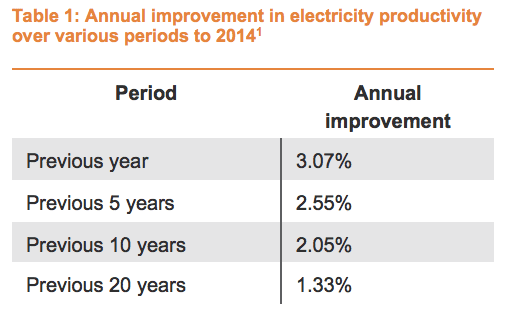This article is part three in a three-part series analysing the future of Australia’s electricity networks, and the federal government’s proposed National Energy Guarantee. You can read part one here, and part two here.
Zero emissions power generation 101: Implement policies that
1) don’t make it hard for existing fossil fuel fired power stations to retire
2) don’t encourage the installation of any new fossil fuel fired power stations
3) ensure that transmission systems support distributed generation.
In the previous papers of this series we looked at the decarbonisation of the electricity sector driven by the changing economics of power generation, and the role transmission networks can play in the management of high levels of variable renewable generation.
We showed that as coal-fired power stations retire at the end of their economic life they will be replaced by a combination of low-cost wind and solar, and gas-fired power to provide firming.
This reflects the energy debate in Australia and the reliability component of the National Energy Guarantee (NEG) whereby new variable renewable generation is likely to be supported by new gas-fired generation.
The expected result?
Electricity and therefore emissions from gas-fired generation will rise.
In this paper, we consider the impact of improving the efficient and productive use of electricity across the economy, and the effect such efforts would have on national emissions.
Reducing national emissions by driving down the demand for energy
Earlier analysis conducted by Energetics assumed that the likely future demand for electricity could be forecast out to 2050 based on recent demand trends.
In particular, the recent trend in electricity productivity improvements, and the ratio between the GDP and electricity consumption.
Table 1 below shows electricity productivity improvements year on year over a series of time horizons.

Our model assumed that electricity productivity improves at a rate of 2.56% per year which means that in 2030 it sits at just more than 40% above the level evidenced in 2016 – an improvement broadly in line with the goal of the National Energy Productivity Plan.
This target of a 40% improvement has been challenged, and arguments presented for a doubling of energy productivity from 2010 to 2030[1].
Doubling electricity productivity by 2030 requires an increase of 3.62% per year, a significant (and many say necessary) improvement in performance. Driving increases to 3.62% per year results in less electricity required for generation in 2050.
The volume of electricity not required in 2050 is equivalent to one-third of Australia’s current consumption.
Doubling energy productivity and continuing this level of improvement delivers greater emissions reductions than the NEG
Doubling energy productivity to 2030 and maintaining the same rate of improvement to 2050 has several significant impacts on Australian’s generation mix in 2030 and 2050.
Business as usual emissions in 2030 fall to 68% of emissions in 2005, which exceeds the target proposed in the NEG consultation. Further, emissions in 2050 fall to 42 Mt CO2-e (down from the 60Mt CO2-e forecast if the rate of improvement of electricity productivity is not lifted).
However, this is still 40 Mt CO2-e too much if Australia is to achieve net zero emissions by 2050.
A change in the rate that electricity productivity improves over time clearly matters to the evolution of Australia’s generation fleet. Other technology trends will also affect the demand for electricity.
These include the electrification of transport particularly through the uptake of electric vehicles, and the electrification of space heating with reverse cycle air conditioners. Both will increase the demand for electricity, with the electrification of transport having a significant and disruptive impact.
All have an impact on the future generation fleet. Therefore:
Zero emissions power generation 101:
1) don’t make it hard for existing fossil fuel fired power stations to retire
2) don’t encourage the installation of any new fossil fuel fired power stations
3) ensure that the transmission systems support distributed generation
4) incorporate measures to minimise electricity consumption while accounting for related technology trends.
Policy making 101
Developing a set of policies that meet the four requirements above, seems to be beyond current policy-makers. The latest proposal from the Federal Government, the National Energy Guarantee, fails on most points:
- It is likely to promote the installation of new fossil-fuel fired generators
- It does not support the development of transmission systems to support distributed generation
- It takes no account of future electricity demand and the trade-offs between investment in generation and investment in electricity productivity.
The Renewable Energy Target doesn’t encourage new fossil fuel fired generators and by increasing generation capacity in the market, places downward pressure of the output of the coal-fired generators.
However, the use of subsidies as promoted by the RET has arguably passed its use by date.
What we need now is space: in the market so that the installation of new, low-cost renewable generation can meet market demand; and space in Australia where new renewable generators can be installed and connected to a robust transmission network.
Energetics’ preliminary modelling suggests that the NEM can sustain high levels of renewable generation without compromising the adequacy and capability of resources in the NEM to deliver electricity to meet demand; especially when renewable generators are coupled with a modest volume of battery storage.
Other studies have also demonstrated this outcome.[2]
The pathway to zero emissions by 2050 can – and should – be met by policies that (strongly) encourage the early retirement of coal-fired power stations, the development of new transmission systems to rich renewable energy zones and the installation of distributed energy storage.
Tyring to solve tomorrow’s challenges with yesterday’s thinking is not a good start.
Dr Gordon Weiss is a Principal Consultant and Associate with Energetics. His expertise lies in energy and carbon policy development, renewable energy technologies and energy management in the resources sector. He has worked with a number of governments on the development of energy and greenhouse gas programs and policies, and is arguably one of Australia’s leading forecasters of emissions reduction trajectories.










